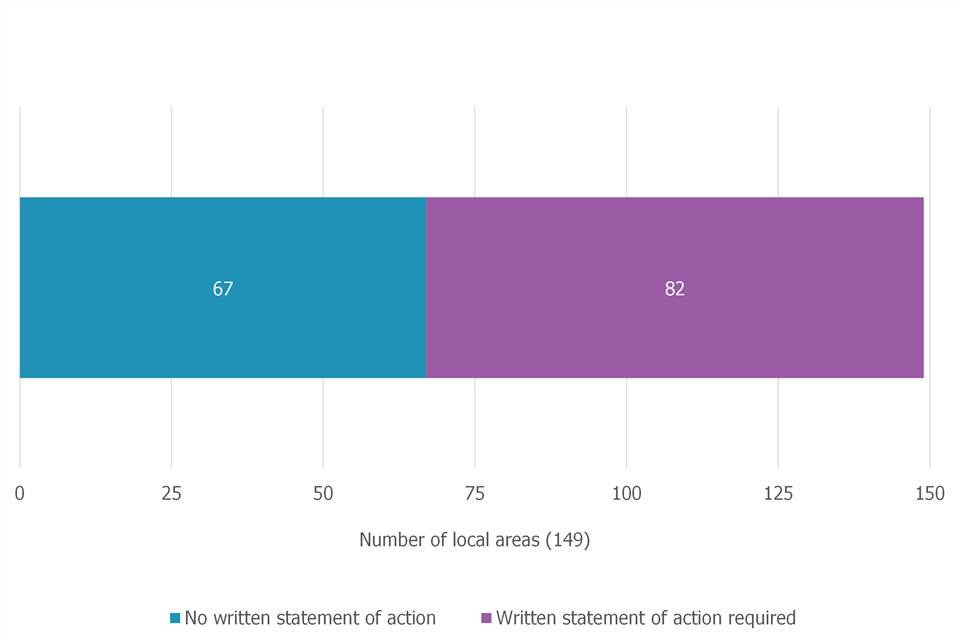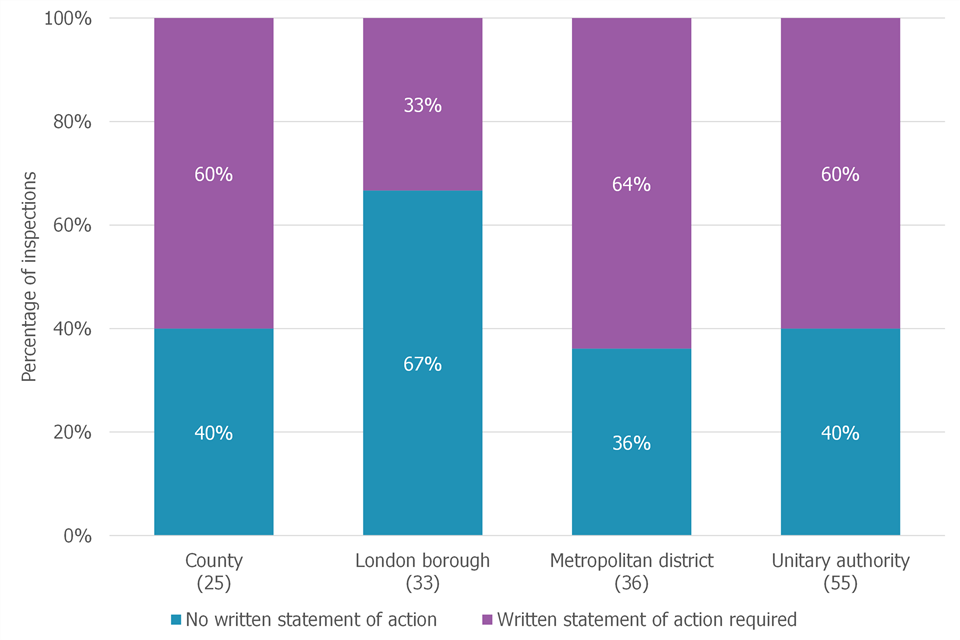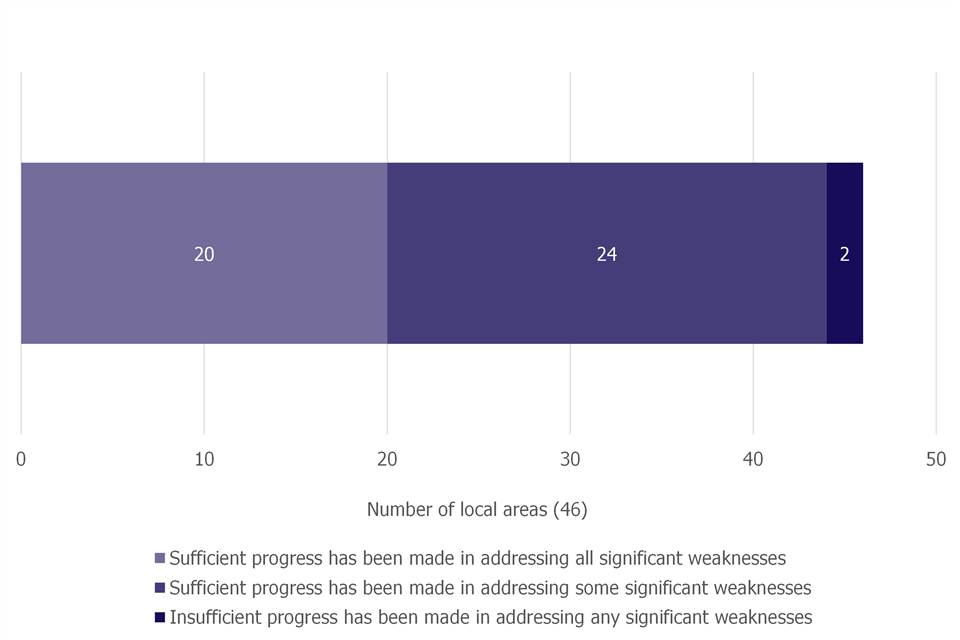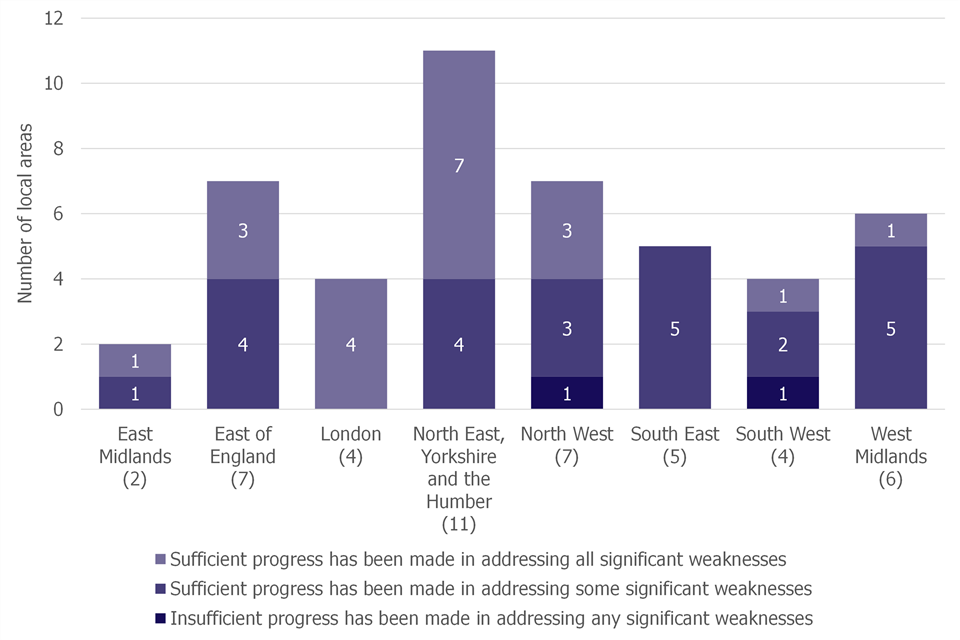Main findings: Area SEND inspections and outcomes in England as at 31 August 2022
Published 17 November 2022
Applies to England
This is the main findings report for the area special educational needs and disabilities (SEND) inspections and outcomes in England 2022 release. The following are also available:
- underlying data
- pre-release access list
Summary
This release contains:
- the number of inspections and outcomes for area SEND inspections carried out between 1 May 2016 and 31 March 2022
- the number of revisits and outcomes for area SEND revisits carried out between 1 December 2018 and 31 August 2022
Main findings
After all local areas have been inspected for SEND, over half (55%) have been required to produce a written statement of action (WSoA), which are required to address significant weaknesses in the local areas’ SEND arrangements.
The proportion of local areas required to produce a WSoA varies across the country. At a regional level, the proportion of local areas with a WSoA ranges from 33% in London to 82% in the East of England.
Inspection outcomes have not varied much since the first year of inspections in 2016–17. Broadly similar proportions of local areas have been required to produce a WSoA in subsequent years. This ranges from 56% in 2019–20 to 68% in 2021–22.
By 31 August 2022, 46 local areas with a WSoA have received a revisit. Under half (20) were making sufficient progress in addressing all significant weaknesses identified during their initial inspection. Just over half (24) had made progress in some, but not all, weaknesses. Two had made insufficient progress in addressing any weaknesses.
Introduction
The Children and Families Act 2014, introduced in September 2014, introduced new legal duties regarding children and young people with SEND. Guidance on these legal duties is in the SEND code of practice. These legal duties place responsibilities on the local area partnership to identify and meet the needs of children and young people up to the age of 25 who have SEND. The local area partnership includes the local authority and health commissioners and providers, together with all of the area’s early years settings, schools and the post-16 further education sector.[footnote 1]
In May 2016, at the request of the Secretary of State for Education, Ofsted and the Care Quality Commission (CQC) introduced a programme of SEND inspections. These assessed how well local areas were implementing the reforms introduced by the Act and the extent to which they were meeting their responsibilities towards children and young people with SEND.
We carried out inspections under section 20 of the Children Act 2004. We inspected under the local area SEND inspection framework, and looked at the way in which local areas were meeting their duties under the Equality Act 2010.
In January 2022, there were 473,000 children and young people aged up to 25 with an education, health and care (EHC) plan. There were also over 1.1 million pupils receiving SEN support in school. Overall, more than 16.5% of children and young people in school are designated as having SEND.
Inspection outcomes are reported in a published letter with judgements in narrative form rather than a 4-point grading scale. The letter outlines areas of strength and key priorities for improvement.
Where His Majesty’s Chief Inspector (HMCI) has determined that a WSoA is required, local area leaders must set out how they will tackle the areas of significant weakness within 70 days of receiving the pre-publication inspection letter. The Department for Education (DfE), working with the Department of Health and Social Care (DHSC) and NHS England when relevant, will seek to engage closely with the local area. If the inspection outcome does not result in a WSoA, the local area is deemed to be meeting its statutory duties in relation to children and young people with SEND. However, this does not mean that the local area cannot do more. Inspectors set out areas for improvement in the inspection letter.
This publication includes all area SEND inspections and revisits completed by 31 August 2022. Reports for this inspection activity have all been published.
Area SEND inspection outcomes as at 31 March 2022
Ofsted and the CQC began joint inspections of area SEND arrangements in May 2016. The 151st, and final, inspection in this initial programme took place during March 2022. Two local areas we inspected no longer exist and are therefore not included in any figures or charts in this publication.[footnote 2]
In just over half (82 out of 149) of area SEND inspections, inspectors had significant concerns about how effectively the local area was meeting its duties or securing better outcomes for children and young people who have SEND. In these 82 cases, HMCI deemed a WSoA was required.
Figure 1: Area SEND inspection outcomes as at 31 March 2022

Note: Number of local areas in brackets.
View data in an accessible table format
Inspection outcomes by year
The selection of local areas inspected in a given year aimed to ensure that there is as even a spread across the country as possible.
Inspections during the first year (2016–17) had the highest proportion of local areas that were not required to produce a WSoA, at just under three quarters of the 29 local areas inspected. However, all subsequent years had lower proportions than year 1, varying from just under half in year 4 (2019–20) to just under a third in year 6 (2021–22), when 11 out of 34 local areas did not require a WSoA.
Figure 2: Area SEND inspection outcomes by year as at 31 March 2022

Note: Number of local areas inspected each year in brackets.
Percentages are rounded.
The reporting year reflects 3 academic terms of area SEND inspections from their inception in the 2016 summer term. Each year covers the summer, autumn and spring terms and effectively runs from April to March.
We deferred several inspections planned for the end of year 4 due to COVID-19 restrictions. If we had continued as planned, we would have carried out a similar number of inspections to previous years.
No inspections took place during year 5 as inspection activity was paused due to COVID-19.
View data in an accessible table format
Inspection outcomes by region
The proportion of local areas required to produce a WSoA varied across the country, from 1 in 3 in London to more than 4 out of 5 in the East of England.
Only 3 out of 8 Ofsted regions have more than half of local areas without a WSoA. These are London, East Midlands and South East.
Figure 3: Area SEND inspection outcomes by region as at 31 March 2022

Note: Number of local areas per region in brackets.
Percentages are rounded and may not sum to 100. Some percentages are based on small numbers, and should be treated with caution.
View data in an accessible table format
Inspection outcomes by local authority type
London has a significantly lower proportion of local areas with a WSoA than other local authorities. This has been consistent over time, with London having the lowest proportion requiring a WSoA each year.
There was some variation within London. In inner London, just over a quarter (4 out of 14) of local areas had a WSoA, while in outer London it was just over a third (7 out of 19).
Figure 4: Area SEND inspection outcomes by local authority type as at 31 March 2022

Note: Number of local areas by local authority type in brackets.
Percentages are rounded and reflect number of inspections for each local authority type.
View data in an accessible table format
Area SEND revisits and outcomes as at 31 August 2022
Ofsted and the CQC do not carry out routine monitoring of local areas with a WSoA. The purpose of a revisit is to determine whether the local area has made sufficient progress in addressing the areas of significant weakness in the WSoA.
Up to March 2020, when area SEND inspections were suspended due to COVID-19, our intention was to revisit local areas within 18 months of the WSoA being declared fit for purpose. When revisits resumed in May 2021, the length of time since the WSoA was produced was taken in consideration when deciding on the sequence of local areas to revisit. Where possible, the same inspectors who conducted the initial inspection also carried out the revisit.
The first revisit took place in December 2018. By 31 August 2022, we had carried out 46 revisits.[footnote 3]
Inspectors found that most local areas were making at least some progress in addressing significant weaknesses. They established that just under half of local areas (20 out of 46) were making sufficient progress in addressing all significant weaknesses. They found around half of local areas (24 out of 46) had made progress in addressing some, but not all, significant weaknesses. Very few (2 out of 46) local areas were found to have not made sufficient progress in any of their significant weaknesses when inspectors revisited.
A higher number of significant weaknesses does not mean that they carry greater cumulative weight than a lower number, because some weaknesses may be more significant or more complex than others.
Figure 5: Area SEND revisit outcomes as at 31 August 2022

Note: Number of local areas in brackets.
Local areas that have not been revisited are not included.
View data in an accessible table format
As at 31 August 2022, there are 36 local areas that have been required to produce a WSoA and are yet to receive a revisit to assess their progress. Twenty-three of these inspections took place after April 2021.
Revisit outcomes by region
The number of revisits completed in each region varies across England, ranging from 2 in East Midlands to 11 in North East, Yorkshire and the Humber.
Only 2 out of 8 regions have a more than half of local areas making sufficient progress in addressing all significant weaknesses. These are London (4 out of 4) and North East, Yorkshire and the Humber (7 out of 11).
Figure 6: Area SEND revisit outcomes by region as at 31 August 2022

Note: Number of local areas per region in brackets.
Local areas that have not been revisited are not included.
View data in an accessible table format
Next steps
If a local area is making insufficient progress in addressing any of the areas of significant weakness, it is for the DfE and NHS England to determine the next steps. This may include the Secretary of State using their powers of intervention. Ofsted and the CQC will not carry out any further inspection activity unless directed to do so by the Secretary of State.
An improvement notice or statutory direction has been issued to a small minority of areas (5) following the revisit. The improvement notice issued to Sefton in July 2019 was lifted in July 2021. The statutory direction issued to Kingston upon Hull in March 2020 was revoked in August 2022. Improvement notices or statutory directions for Birmingham, North Somerset and Devon were issued more recently and were still open on 31 October 2022.
A new area SEND framework
The DfE, with the support of the DHSC, has commissioned Ofsted and the CQC to develop a new ongoing area SEND inspection framework to operate from early 2023. There will be no accountability gap between inspection frameworks, as we will continue to carry out revisits under the current framework to areas issued with a WSoA before March 2020 until the new framework is introduced.
Refer to a new approach to area SEND inspections for more information, which includes the draft inspection framework and handbook.
Glossary
Definitions of terms are in the statistical glossary.
Further information
Structural changes to local government
Structural changes to local government have been made in several areas in recent years. Two local areas we inspected no longer exist. Figures and charts do not reflect inspection activity for Dorset and Northamptonshire.
Dorset were inspected in January 2017 and required a WSoA. The revisit took place in February 2019 and Dorset were deemed to be making sufficient progress in addressing some significant weaknesses. The new boundaries came into effect on 1st April 2019.
Northamptonshire were inspected in May 2017 and did not require a WSoA. The replacement areas were established on 1st April 2021.
Contacts
If you are a member of the public and have any comments or feedback on this publication, please contact Adam King on 0300 013 0020 or the social care data and analysis team on socialcaredata@ofsted.gov.uk.
Press enquiries should be sent to our press team on pressenquiries@ofsted.gov.uk.
Acknowledgements
Thanks to Richard Fisher for his contribution to this statistical release.
Annex: data tables for figures
This section contains the underlying data in an accessible table format for all figures.
Data for Figure 1: Area SEND inspection outcomes as at 31 March 2022
| Group | No written statement of action | Written statement of action required | Total |
|---|---|---|---|
| Local areas | 67 | 82 | 149 |
See Figure 1
Data for Figure 2: Number of local areas for Area SEND inspection outcomes by year as at 31 March 2022
| Reporting year | No written statement of action | Written statement of action required | Total |
|---|---|---|---|
| Year 1 (2016–17) | 21 | 8 | 29 |
| Year 2 (2017–18) | 12 | 16 | 28 |
| Year 3 (2018–19) | 12 | 21 | 33 |
| Year 4 (2019–20) | 11 | 14 | 25 |
| Year 5 (2020–21) | 0 | 0 | 0 |
| Year 6 (2021–22) | 11 | 23 | 34 |
Data for Figure 2: Percentage of local areas for Area SEND inspection outcomes by year as at 31 March 2022
| Reporting year | No written statement of action | Written statement of action required |
|---|---|---|
| Year 1 (2016–17) | 72% | 28% |
| Year 2 (2017–18) | 43% | 57% |
| Year 3 (2018–19) | 36% | 64% |
| Year 4 (2019–20) | 44% | 56% |
| Year 5 (2020–21) | n/a | n/a |
| Year 6 (2021–22) | 32% | 68% |
See Figure 2
Data for Figure 3: Number of local areas for Area SEND inspection outcomes by region as at 31 March 2022
| Ofsted region | No written statement of action | Written statement of action required | Total |
|---|---|---|---|
| East Midlands | 5 | 3 | 8 |
| East of England | 2 | 9 | 11 |
| London | 22 | 11 | 33 |
| North East, Yorkshire and the Humber | 7 | 20 | 27 |
| North West | 10 | 13 | 23 |
| South East | 10 | 9 | 19 |
| South West | 6 | 8 | 14 |
| West Midlands | 5 | 9 | 14 |
Data for Figure 3: Percentage of local areas for Area SEND inspection outcomes by region as at 31 March 2022
| Ofsted region | No written statement of action | Written statement of action required |
|---|---|---|
| East Midlands | 63% | 38% |
| East of England | 18% | 82% |
| London | 67% | 33% |
| North East, Yorkshire and the Humber | 26% | 74% |
| North West | 43% | 57% |
| South East | 53% | 47% |
| South West | 43% | 57% |
| West Midland | 36% | 64% |
See Figure 3
Data for Figure 4: Number of local areas for Area SEND inspection outcomes by local authority type as at 31 March 2022
| Local authority type | No written statement of action | Written statement of action required | Total |
|---|---|---|---|
| County | 10 | 15 | 25 |
| London borough | 22 | 11 | 33 |
| Metropolitan district | 13 | 23 | 36 |
| Unitary authority | 22 | 33 | 55 |
Data for Figure 4: Percentage of local areas for Area SEND inspection outcomes by local authority type as at 31 March 2022
| Local authority type | No written statement of action | Written statement of action required |
|---|---|---|
| County | 40% | 60% |
| London borough | 67% | 33% |
| Metropolitan district | 36% | 64% |
| Unitary authority | 40% | 60% |
See Figure 4
Data for Figure 5: Area SEND revisit outcomes as at 31 August 2022
| Group | Sufficient progress has been made in addressing all significant weaknesses | Sufficient progress has been made in addressing some significant weaknesses | Insufficient progress has been made in addressing any significant weaknesses | Total |
|---|---|---|---|---|
| Local areas | 20 | 24 | 2 | 46 |
See Figure 5
Data for Figure 6: Area SEND revisit outcomes by region as at 31 August 2022
| Ofsted region | Sufficient progress has been made in addressing all significant weaknesses | Sufficient progress has been made in addressing some significant weaknesses | Insufficient progress has been made in addressing any significant weaknesses | Total |
|---|---|---|---|---|
| East Midlands | 1 | 1 | 0 | 2 |
| East of England | 3 | 4 | 0 | 7 |
| London | 4 | 0 | 0 | 4 |
| North East, Yorkshire and the Humber | 7 | 4 | 0 | 11 |
| North West | 3 | 3 | 1 | 7 |
| South East | 0 | 5 | 0 | 5 |
| South West | 1 | 2 | 1 | 4 |
| West Midlands | 1 | 5 | 0 | 6 |
See Figure 6
-
The terms ‘local area partnership’ and ‘local area’ refer to those responsible for the strategic planning, commissioning, management, delivery and evaluation of arrangements for children and young people with SEND. These include the local authority and clinical commissioning group or integrated care board, and other area partners as set out in the Children and Families Act 2014 and described in the SEND code of practice. ↩
-
Structural changes to local government have been made in several areas in recent years. Two local areas we inspected no longer exist. Figures and charts do not reflect the inspection outcomes for Dorset and Northamptonshire. We inspected Dorset in January 2017 and it required a WSoA. We inspected Northamptonshire in May 2017 and it did not require a WSoA. Routine inspections were suspended between March 2020 and June 2021 due to COVID-19. ↩
-
We revisited Dorset in February 2019 before structural changes to local government and it is therefore not included in the figures. We deemed Dorset to be making sufficient progress in addressing some significant weaknesses. Routine revisits were suspended between March 2020 and May 2021 due to COVID-19. ↩

